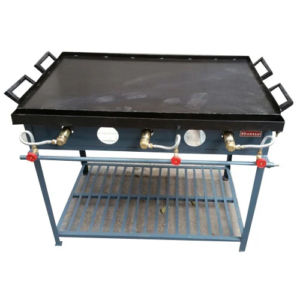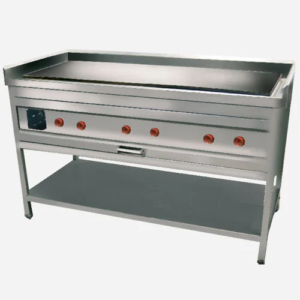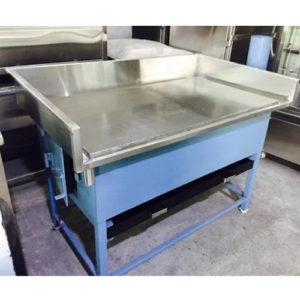Dosa Plate
-
-
₹17,990.00
Silver Hot Plate Dosa Bhatti For Restaurant
₹17,990.00 -
₹22,000.00
Stainless Steel Dosa Bhatti for Restaurant
₹22,000.00 -
-
-
-
Dosa Plate: Your Essential Guide to Perfecting Dosa Making at Home
Introduction to Dosa Plates
If you’ve ever enjoyed the crispy, flavorful delight of a dosa, you know just how satisfying this South Indian dish can be. Whether it’s for breakfast, lunch, or dinner, dosas are not only delicious but also versatile. To master the art of dosa-making, having the right tools is essential. One of the most important tools in this culinary adventure is a dosa plate. This guide will explore everything you need to know about dosa plates, their features, benefits, and how to choose the right one for your kitchen.
What is a Dosa Plate?
A dosa plate, often referred to as a dosa pan or griddle, is a flat cooking surface designed specifically for making dosas. It is usually made from materials like cast iron, non-stick, or stainless steel. The dosa plate is designed to evenly distribute heat, ensuring that the batter cooks uniformly and achieves that perfect crispy texture.
Key Features of Dosa Plates
- Material: The material of the dosa plate affects cooking performance. Common materials include:
- Cast Iron: Offers excellent heat retention and durability. Ideal for achieving that authentic crispy texture.
- Non-Stick: Easier to clean and prevents the dosa from sticking, making it suitable for beginners.
- Stainless Steel: Durable and resistant to rust, providing a sleek look while ensuring even heat distribution.
- Size: Dosa plates come in various sizes, typically ranging from 10 inches to 15 inches in diameter. Choosing the right size depends on your cooking needs and the number of dosas you plan to make at once.
- Thickness: A thicker plate retains heat better and cooks dosas more evenly, while a thinner plate may heat up quickly but can lead to uneven cooking.
- Handle: Some dosa plates come with a detachable handle, while others have a fixed one. A comfortable handle makes it easier to maneuver the plate while cooking.
- Compatibility: Ensure that the dosa plate is compatible with your cooking method—whether it’s gas, electric, or induction cooktops.
Benefits of Using a Dosa Plate
- Even Cooking: Dosa plates are designed to distribute heat evenly, ensuring that your dosas cook uniformly without burning.
- Crispy Texture: A well-made dosa plate allows for optimal moisture evaporation, resulting in perfectly crispy dosas.
- Versatility: While primarily used for dosas, these plates can also be used for making other dishes like pancakes, uttapams, and crepes.
- Durability: High-quality dosa plates, especially those made from cast iron or stainless steel, are built to last, providing great value over time.
- Healthier Cooking: Many non-stick dosa plates require less oil for cooking, making it easier to prepare healthier meals.
How to Choose the Right Dosa Plate
1. Consider the Material
- Cast Iron: Great for those who prefer a traditional cooking experience. Requires seasoning to maintain its non-stick properties but provides excellent heat retention.
- Non-Stick: Ideal for beginners and those who want easy cleanup. Make sure to choose a high-quality non-stick surface to avoid scratches and wear over time.
- Stainless Steel: Offers a modern look and durability. While it may require a bit more oil to prevent sticking, it is easy to clean and maintain.
2. Determine the Size
Choose a size based on your cooking needs. If you frequently prepare large meals or entertain guests, a larger dosa plate (12 inches or more) may be beneficial. For smaller households, a 10-11 inch plate could suffice.
3. Evaluate the Thickness
A thicker dosa plate is generally better for heat retention and even cooking. Look for plates that are at least 4-5 mm thick for the best results.
4. Check for Compatibility
Ensure that the dosa plate is compatible with your stovetop. If you have an induction cooktop, make sure to purchase an induction-compatible dosa plate.
5. Look for Additional Features
Some dosa plates come with features such as temperature indicators, easy-grip handles, or detachable handles for storage. Consider these features based on your cooking habits and preferences.
Maintenance and Care for Your Dosa Plate
To ensure the longevity of your dosa plate, follow these maintenance tips:
1. Seasoning Cast Iron Plates
If you choose a cast iron dosa plate, seasoning is essential. To season your plate:
- Clean the plate with hot water and a scrubber.
- Dry it thoroughly.
- Apply a thin layer of vegetable oil.
- Heat the plate on low for 30 minutes to allow the oil to seep into the pores.
2. Cleaning Non-Stick Plates
For non-stick dosa plates, use a soft sponge and mild dish soap to clean the surface. Avoid abrasive cleaners and metal utensils to prevent scratching.
3. Storing Your Dosa Plate
Store your dosa plate in a cool, dry place. For cast iron plates, consider placing a paper towel between the plate and any other cookware to absorb moisture and prevent rust.
4. Avoid Sudden Temperature Changes
Avoid exposing your dosa plate to sudden temperature changes, as this can warp the material. Always preheat gradually and let it cool down slowly.
Frequently Asked Questions (FAQs)
1. What is the best material for a dosa plate?
The best material depends on your cooking style. Cast iron offers traditional cooking and excellent heat retention, while non-stick is easier to clean and requires less oil. Stainless steel is durable and modern but may need more oil to prevent sticking.
2. How do I clean my dosa plate?
For cast iron plates, use hot water and a scrubber, then dry thoroughly. For non-stick plates, use a soft sponge with mild soap. Avoid abrasive materials that can damage the surface.
3. Can I use my dosa plate on an induction cooktop?
Yes, but ensure that the dosa plate is induction-compatible. Not all plates are suitable for induction cooking.
4. How do I prevent dosas from sticking to the plate?
Make sure your dosa plate is adequately preheated before pouring the batter. For cast iron, proper seasoning is crucial. For non-stick, using a little oil can help prevent sticking.
5. What size dosa plate should I buy?
The size depends on your cooking needs. A larger plate (12 inches or more) is suitable for families or gatherings, while a smaller plate (10-11 inches) is perfect for individual servings.
6. Can I use a dosa plate for other types of cooking?
Yes! While designed for dosas, these plates can also be used for pancakes, uttapams, and even grilled sandwiches.
7. How do I store my dosa plate?
Store your dosa plate in a cool, dry place. For cast iron, consider placing a paper towel between it and other cookware to absorb moisture and prevent rust.
8. Is a non-stick dosa plate better for beginners?
Yes, non-stick dosa plates are generally easier to use for beginners, as they require less oil and are easier to clean.
Conclusion
A dosa plate is an indispensable tool for anyone looking to enjoy the delightful experience of making dosas at home. With the right plate, you can achieve the perfect texture and flavor every time. From choosing the right material and size to maintaining your plate for longevity, this guide has equipped you with all the knowledge you need.








